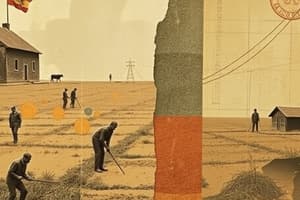Podcast
Questions and Answers
What were some of the reasons that contributed to the economic hardship experienced in Europe during the 1830s?
What were some of the reasons that contributed to the economic hardship experienced in Europe during the 1830s?
- Increased industrial production led to widespread unemployment.
- A rise in the price of food and a year of bad harvests leading to widespread poverty. (correct)
- A decline in agricultural production due to widespread disease.
- Competition from cheap, machine-made goods imported from England. (correct)
What was a significant consequence of the events of February 1848 in France?
What was a significant consequence of the events of February 1848 in France?
- The establishment of a constitutional monarchy.
- The proclamation of a republic based on universal male suffrage. (correct)
- The adoption of a new constitution guaranteeing freedom of speech and religion.
- The abolition of feudalism and the redistribution of land.
Which group was primarily responsible for the revolution that swept through Europe in 1848?
Which group was primarily responsible for the revolution that swept through Europe in 1848?
- The peasantry.
- The aristocracy.
- The educated middle class. (correct)
- The working class.
What were the key demands of the liberals during the revolutions of 1848 in Europe?
What were the key demands of the liberals during the revolutions of 1848 in Europe?
How did the German Liberal Movement of 1848 manifest itself?
How did the German Liberal Movement of 1848 manifest itself?
What was the ultimate fate of the German Liberal Movement's proposed constitution in 1848?
What was the ultimate fate of the German Liberal Movement's proposed constitution in 1848?
In what way did the German Liberal Movement of 1848 resemble the broader European liberal movement of the time?
In what way did the German Liberal Movement of 1848 resemble the broader European liberal movement of the time?
What does the content suggest about the relationship between economic hardship and political unrest in Europe during the mid-19th century?
What does the content suggest about the relationship between economic hardship and political unrest in Europe during the mid-19th century?
Flashcards
Economic Hardship in 1830s Europe
Economic Hardship in 1830s Europe
The decade faced severe economic crises due to population growth and job scarcity.
Population Increase
Population Increase
The 1830s saw a significant rise in population across Europe, straining resources.
Competition from Imports
Competition from Imports
Small producers struggled against cheap machine-made goods from England.
1848 Revolutions
1848 Revolutions
Signup and view all the flashcards
French Revolution of 1848
French Revolution of 1848
Signup and view all the flashcards
Liberal Demands in 1848
Liberal Demands in 1848
Signup and view all the flashcards
German Liberal Movement 1848
German Liberal Movement 1848
Signup and view all the flashcards
Rejection of Constitution
Rejection of Constitution
Signup and view all the flashcards
Study Notes
Economic Hardship in 1830s Europe
- Europe experienced significant economic hardship in the 1830s.
- Increased population led to a job market imbalance.
- Rural-to-urban migration worsened the situation.
- Competition from cheap, machine-made English goods affected small producers.
- Feudal dues and obligations burdened peasants in aristocratic regions.
- Poor harvests and rising food prices caused widespread poverty.
Significance of 1848 in Europe
- 1848 saw revolts across Europe, driven by the poor, unemployed, and starving.
- The February 1848 French revolution resulted in the monarchy's abdication, establishing a republic.
- Liberal middle classes in other European countries combined demands for constitutionalism and national unification.
- Liberals sought parliamentary principles, including a constitution, a free press, and freedom of association.
- The women's suffrage issue was a contentious topic in the liberal movement.
German Liberal Movement of 1848
- German middle-class professionals, businessmen, and artisans formed political associations.
- An all-German National Assembly was established in Frankfurt.
- The Frankfurt Parliament drafted a constitution for a unified German nation.
- The Prussian king, Friedrich Wilhelm IV rejected the constitution and opposed the assembly.
- The assembly lacked support from the lower classes and ultimately disbanded.
Studying That Suits You
Use AI to generate personalized quizzes and flashcards to suit your learning preferences.




